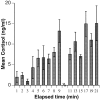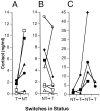Stress and dominance in a social fish
- PMID: 9236253
- PMCID: PMC6568347
- DOI: 10.1523/JNEUROSCI.17-16-06463.1997
Stress and dominance in a social fish
Abstract
Many aspects of reproductive physiology are subject to regulation by social interactions. These include changes in neural and physiological substrates of reproduction. How can social behavior produce such changes? In experiments reported here, we manipulated the social settings of teleost fish and measured the effect (1) on stress response as reflected in cortisol production, (2) on reproductive potential as measured in production of the signaling peptide, gonadotropin-releasing hormone, and (3) on reproductive function measured in gonad size. Our results reveal that the level of the stress hormone cortisol depends critically on both the social and reproductive status of an individual fish and on the stability of its social situation. Moreover, the reproductive capacity of an individual fish depends on these same variables. These results show that social encounters within particular social contexts have a profound effect on the stress levels as well as on reproductive competence. Social behavior may lead to changes in reproductive state through integration of cortisol changes in time. Thus, information available from the stress pathway may provide socially relevant signals to produce neural change.
Figures





Similar articles
-
Physiological consequences of social descent: studies in Astatotilapia burtoni.J Endocrinol. 2006 Jul;190(1):183-90. doi: 10.1677/joe.1.06755. J Endocrinol. 2006. PMID: 16837622
-
Social regulation of the brain-pituitary-gonadal axis.Proc Natl Acad Sci U S A. 1993 Aug 15;90(16):7794-8. doi: 10.1073/pnas.90.16.7794. Proc Natl Acad Sci U S A. 1993. PMID: 8356086 Free PMC article.
-
Dominance hierarchies and social status ascent opportunity: anticipatory behavioral and physiological adjustments in a Neotropical cichlid fish.Physiol Behav. 2012 Jul 16;106(5):612-8. doi: 10.1016/j.physbeh.2012.04.003. Epub 2012 Apr 12. Physiol Behav. 2012. PMID: 22521514
-
Social information changes the brain.Proc Natl Acad Sci U S A. 2012 Oct 16;109 Suppl 2(Suppl 2):17194-9. doi: 10.1073/pnas.1202552109. Epub 2012 Oct 8. Proc Natl Acad Sci U S A. 2012. PMID: 23045669 Free PMC article. Review.
-
Stress and behaviorally induced reproductive dysfunction in primates.Semin Reprod Endocrinol. 1997 Feb;15(1):37-45. doi: 10.1055/s-2008-1067966. Semin Reprod Endocrinol. 1997. PMID: 9065976 Review.
Cited by
-
Social status controls somatostatin neuron size and growth.J Neurosci. 2000 Jun 15;20(12):4740-4. doi: 10.1523/JNEUROSCI.20-12-04740.2000. J Neurosci. 2000. PMID: 10844043 Free PMC article.
-
Color change as a potential behavioral strategy.Horm Behav. 2008 Aug;54(3):463-70. doi: 10.1016/j.yhbeh.2008.05.006. Epub 2008 May 22. Horm Behav. 2008. PMID: 18586245 Free PMC article.
-
Mechanisms of social behaviour in the anti-social blind cavefish (Astyanax mexicanus).Proc Biol Sci. 2025 Mar;292(2043):20250052. doi: 10.1098/rspb.2025.0052. Epub 2025 Mar 26. Proc Biol Sci. 2025. PMID: 40132632
-
Social competition affects electric signal plasticity and steroid levels in the gymnotiform fish Brachyhypopomus gauderio.Horm Behav. 2009 Oct;56(4):399-409. doi: 10.1016/j.yhbeh.2009.07.009. Epub 2009 Aug 6. Horm Behav. 2009. PMID: 19647742 Free PMC article.
-
Phenotypic and genetic integration of personality and growth under competition in the sheepshead swordtail, Xiphophorus birchmanni.Evolution. 2018 Jan;72(1):187-201. doi: 10.1111/evo.13398. Epub 2017 Nov 30. Evolution. 2018. PMID: 29148573 Free PMC article.
References
-
- Ahima RS, Harlan RE. Glucocorticoid receptors in LHRH neurons. Neuroendocrinology. 1992;56:845–850. - PubMed
-
- Alberts SC, Altmann J, Sapolsky RM. Behavioral, endocrine, and immunological correlates of immigration by an aggressive male into a natural primate group. Horm Behav. 1992;26:163–173. - PubMed
-
- Balm PHM, Pepels P, Helfrich S, Hovens MLM, Wendelaar Bonga SE. Adrenocorticotropic hormone in relation to interrenal function during stress in tilapia (Oreochromis mossambicus). Gen Comp Endocrinol. 1994;96:347–360. - PubMed
-
- Bass A. Dimorphic male brains and alternative reproductive tactics in a vocalizing fish. Trends Neuroci. 1992;15:139–145. - PubMed
-
- Bennett NC, Faulkes CG, Molteno AJ. Reproductive suppression in subordinate, non-breeding female Damaraland mole-rats: two components to a lifetime of socially induced infertility. Proc R Soc Lond [Biol] 1996;263:1599–1603. - PubMed
Publication types
MeSH terms
Substances
Grants and funding
LinkOut - more resources
Full Text Sources
Miscellaneous
